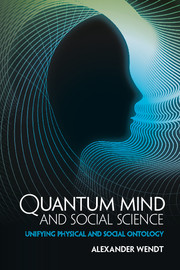Book contents
- Frontmatter
- Dedication
- Epigraph
- Contents
- Acknowledgments
- 1 Preface to a quantum social science
- Part I Quantum theory and its interpretation
- Part II Quantum consciousness and life
- 5 Quantum brain theory
- 6 Panpsychism and neutral monism
- 7 A quantum vitalism
- Part III A quantum model of man
- Part IV Language, light, and other minds
- Part V The agent-structure problem redux
- Conclusion
- Bibliography
- Index
6 - Panpsychism and neutral monism
from Part II - Quantum consciousness and life
Published online by Cambridge University Press: 05 May 2015
- Frontmatter
- Dedication
- Epigraph
- Contents
- Acknowledgments
- 1 Preface to a quantum social science
- Part I Quantum theory and its interpretation
- Part II Quantum consciousness and life
- 5 Quantum brain theory
- 6 Panpsychism and neutral monism
- 7 A quantum vitalism
- Part III A quantum model of man
- Part IV Language, light, and other minds
- Part V The agent-structure problem redux
- Conclusion
- Bibliography
- Index
Summary
Although this book is about the implications for social science of a quantum approach to the mind, much of that potential stems from its ability to integrate consciousness – a particular aspect of the mind – into a naturalistic worldview. And when it comes to the hard problem, quantum brain theory is only a necessary condition for such integration, not sufficient. Necessary, because it would enable the body to exploit for macro-level purposes a physical but non- material space for consciousness at the quantum level – collapse of the wave function – that does not exist in classical physics. Insufficient, however, because quantum brain theory embodies an objective, third-person standpoint and as such can tell us no more than classical brain theory can about why brains have a subjective, first-person point of view in the first place. The explanatory gap is still there, in other words, only now pushed down into quantum theory. To cross this gap, therefore, in addition to a new physics of the brain we will need a new meta-physics as well. As I argue in this chapter, it is this metaphysics that does the real work in solving the mind–body problem.
Most social scientists have an instinctive aversion to ‘metaphysics,’ which in our world connotes wooly-headed and speculative thinking that has no place in science. Yet in moving onto this terrain the situation is both worse and better than that. It is worse because we have no choice. The Neuron Doctrine itself is based on a metaphysic, materialism, which looks increasingly unlikely to ever explain consciousness; and in thinking about the meaning of quantum theory metaphysical debate can hardly be avoided, precisely because physics provides little guidance for choosing among its interpretations. So the only question is whether to change our metaphysics of the brain from classical to quantum.
- Type
- Chapter
- Information
- Quantum Mind and Social ScienceUnifying Physical and Social Ontology, pp. 109 - 130Publisher: Cambridge University PressPrint publication year: 2015



